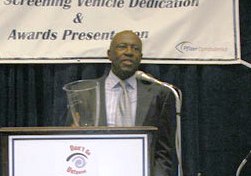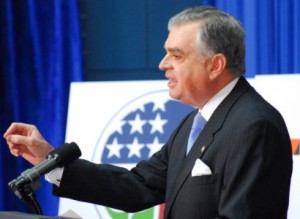Committee chairman Edolphus Towns opened his Toyota safety hearings today with harsh words: “NHTSA failed the taxpayers. Toyota failed their customers – we now have 39 deaths attributed to Toyota products,” said Towns.
“If Camry and Prius were airplanes they would be grounded,” said Towns.
Department of Transportation Secretary Ray LaHood said that any of the Toyota vehicles subject to recall “are not safe.”
“If your car is listed take it to the dealer to get it fixed,” said LaHood.
Toyota’s recalls – thus far – address five separate Toyota product safety issues. In total, some 5.3 million Toyota vehicles across 14 model lines are affected by one or more of
these recalls in the United States.
Millions more Toyota products are involved in global recalls.
Toyota, of course, initially and subsequently asserted that unintended acceleration was solely the result of “pedal entrapment” from floor mats.
That assertion was negated when NHTSA investigators found the floor mats of a Toyota locked in the trunk of a vehicle that was involved in a fatal accident.
La Hood said that there are people who now believe that there are electronic problems that might be causing unintended acceleration in Toyota vehicles. NHTSA is investigating this, in spite of vehement denials from Toyota that electronics are not responsible. And indeed assertions were made yesterday at another Congressional hearing by a “surprise witness” of questionable or at least unknown background.
“We are going to go in the weeds on this,” LaHood said about a review of electronic issues. “And we need Toyota’s cooperation on that.”
Much more need to be explored around this Toyota matter in our view. (Click here for a more detailed discussion.) And questions also remain whether the 700 civil service employees of NHTSA are capable of accurately assessing safety concerns, particularly in electronic equipment and control areas that the auto industry is rushing headlong into .
LaHood defended his employees for taking safety seriously. About 125 engineers are working on safety matters at NHTSA. However, LaHood was coy in our view, professing ignorance on how many software engineers NHTSA actually has.
During the last three years NHTSA has recalled 23 million cars from various makers, LaHood said, concluding that Toyota has not received favorable treatment.
“We will not compromise when it comes to safety,” LaHood claimed. “And I will state for the record we will hold Toyota’s feet to the fire,” LaHood said.
The Saylor accident (click here) was used at the outset of the hearing as an example of lack of regulatory effectiveness that resulted in deaths.
On August 28, 2009, California Highway Patrol officer Mark Saylor and three members of his family, Cleofe, Mahala, and Cleofe’s brother Chris Lastrella died on a highway near San Diego California, while driving a 2009 ES350 lent to them by a local Lexus dealer.
One of the tragic questions – thus far unresolved – is why didn’t a trained police officer, who was on the phone to 911 when the accident occurred, didn’t simply put the car in neutral or press the large start-stop button to the right of the steering wheel to bring the Lexus under control?
More troubling is the fact revealed yesterday that the Lexus car in question had previous complaints of unintended acceleration and it was still in service.



Herewith the prepared testimony of Akio Toyoda, President, Toyota Motor Corporation, to the Committee on Oversight and Government Reform, February 24, 2010. Toyoda delivered the remarks as prepared. – KZ, editor.
“Thank you Chairman Towns.
“I am Akio Toyoda of Toyota Motor Corporation. I would first like to state that I love cars as much as anyone, and I love Toyota as much as anyone. I take the utmost pleasure in offering vehicles that our customers love, and I know that Toyota’s 200,000 team members, dealers, and suppliers across America feel the same way. However, in the past few months, our customers have started to feel uncertain about the safety of Toyota’s vehicles, and I take full responsibility for that. Today, I would like to explain to the American people, as well as our customers in the U.S. and around the world, how seriously Toyota takes the quality and safety of its vehicles. I would like to express my appreciation to Chairman Towns and Ranking Member Issa, as well as the members of the House Oversight and Government Reform Committee, for giving me this opportunity to express my thoughts today.
“I would like to focus my comments on three topics – Toyota’s basic philosophy regarding quality control, the cause of the recalls, and how we will manage quality control going forward.
“First, I want to discuss the philosophy of Toyota’s quality control. I myself, as well as Toyota, am not perfect. At times, we do find defects. But in such situations, we always stop, strive to understand the problem, and make changes to improve further. In the name of the company, its long-standing tradition and pride, we never run away from our problems or pretend we don’t notice them. By making continuous improvements, we aim to continue offering even better products for society. That is the core value we have kept closest to our hearts since the founding days of the company.
“At Toyota, we believe the key to making quality products is to develop quality people. Each employee thinks about what he or she should do, continuously making improvements, and by doing so, makes even better cars. We have been actively engaged in developing people who share and can execute on this core value. It has been over 50 years since we began selling in this great country, and over 25 years since we started production here. And in the process, we have been able to share this core value with the 200,000 people at Toyota operations, dealers, and suppliers in this country. That is what I am most proud of.
“Second, I would like to discuss what caused the recall issues we are facing now. Toyota has, for the past few years, been expanding its business rapidly. Quite frankly, I fear the pace at which we have grown may have been too quick. I would like to point out here that Toyota’s priority has traditionally been the following: First; Safety, Second; Quality, and Third; Volume. These priorities became confused, and we were not able to stop, think, and make improvements as much as we were able to before, and our basic stance to listen to customers’ voices to make better products has weakened somewhat. We pursued growth over the speed at which we were able to develop our people and our organization, and we should sincerely be mindful of that. I regret that this has resulted in the safety issues described in the recalls we face today, and I am deeply sorry for any accidents that Toyota drivers have experienced.
“Especially, I would like to extend my condolences to the members of the Saylor family, for the accident in San Diego. I would like to send my prayers again, and I will do everything in my power to ensure that such a tragedy never happens again.
“Since last June, when I first took office, I have personally placed the highest priority on improving quality over quantity, and I have shared that direction with our stakeholders. As you well know, I am the grandson of the founder, and all the Toyota vehicles bear my name. For me, when the cars are damaged, it is as though I am as well. I, more than anyone, wish for Toyota’s cars to be safe, and for our customers to feel safe when they use our vehicles. Under my leadership, I would like to reaffirm our values of placing safety and quality the highest on our list of priorities, which we have held to firmly from the time we were founded. I will also strive to devise a system in which we can surely execute what we value.
“Third, I would like to discuss how we plan to manage quality control as we go forward. Up to now, any decisions on conducting recalls have been made by the Customer Quality Engineering Division at Toyota Motor Corporation in Japan. This division confirms whether there are technical problems and makes a decision on the necessity of a recall. However, reflecting on the issues today, what we lacked was the customers’ perspective.
“To make improvements on this, we will make the following changes to the recall decision making process. When recall decisions are made, a step will be added in the process to ensure that management will make a responsible decision from the perspective of “customer safety first.” To do that, we will devise a system in which customers’ voices around the world will reach our management in a timely manner, and also a system in which each region will be able to make decisions as necessary. Further, we will form a quality advisory group composed of respected outside experts from North America and around the world to ensure that we do not make a misguided decision. Finally, we will invest heavily in quality in the U.S., through the establishment of an Automotive Center of Quality Excellence, the introduction of a new position – Product Safety Executive, and the sharing of more information and responsibility within the company for product quality decisions, including defects and recalls.
“Even more importantly, I will ensure that members of the management team actually drive the cars, and that they check for themselves where the problem lies as well as its severity. I myself am a trained test driver. As a professional, I am able to check on problems in a car, and can understand how severe the safety concern is in a car. I drove the vehicles in the accelerator pedal recall as well as the Prius, comparing the vehicles before and after the remedy in various environmental settings. I believe that only by examining the problems on-site, can one make decisions from the customer perspective. One cannot rely on reports or data in a meeting room.
“Through the measures I have just discussed, and with whatever results we obtain from the investigations we are conducting in cooperation with NHTSA, I intend to further improve on the quality of Toyota vehicles and fulfill our principle of putting the customer first.
“My name is on every car. You have my personal commitment that Toyota will work vigorously and unceasingly to restore the trust of our customers.
“Thank you.”